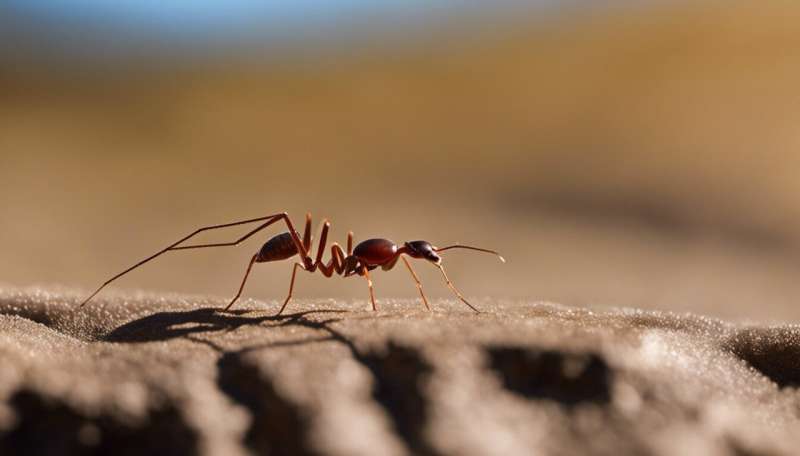Credit: AI-generated image (disclaimer)
We Californians are a bit like Goldilocks: We like it neither too wet nor too dry, too hot nor too cold.
We are not alone. The Argentine ant shares our climate preferences. They also share a huge chunk of the state, with what amounts to a single super-colony. And when the climate is not to their liking, they seem to expect us to share our homes as well.
"On the face of it, you wouldn't think they'd be so invasive," says David Holway, a professor in the Ecology, Behavior and Evolution Section of UC San Diego's Division of Biological Sciences and an expert on ants. "Argentine ants have a narrow environmental tolerance; they like areas that are warm and humid."
In August and September, California was way too dry for them. The ants' quest for water led them to our bathrooms and kitchens, swarming in faucets and over toilets. In December, it was too wet: Rains sent them marching into our cozy, dry homes, sometimes right over the threshold. We spray; we set out bait stations; we try home remedies like borax and cinnamon. We kill the ones we see; but we know there are more.
"There is no silver bullet," says Philip Ward, an ant systematist at UC Davis. In urban California, "they are here to stay."
An entrenched visitor
Holway and Ward are among several entomologists throughout the UC system whose research focuses on the pesky Argentine ant, or Linepithema humile. In explaining the ant's history in North America—they first landed in New Orleans late in the 19th century—Ward notes that the ants of our super-colony are, basically, one great extended family. "Mostly, they are genetically quite similar." Thus, they don't attack or compete with each other.
While they are inflexible about climate, Argentine ants are flexible about where they live. "They like rotting wood, the top layers of soil, wild plants, potted plants, wood chips, compost, trash," Holway explains. "It's that nesting behavior that allows them to get around so much, and to live close to us."
Their prevalence has implications beyond home invasions. Gardeners and farmers are well aware of mutualism—how ants protect pests such as aphids and mealybugs, which feed on both crops and ornamentals. Citrus and grapes—key crops in California—are affected.
And as Argentine ants protect pests, they also drive out native ant species. Displacing native harvester ants has had a domino effect: The coast horned lizard, which feeds primarily on harvester ants, has vanished from large portions of its former range. The ant's introduction to the Channel Islands has been of particular concern.
"We're working with the U.S. Park Service, the U.S. Navy and the Nature Conservancy to control them," says Holway, whose research has long focused on why the insects invade some areas, and not others.
Goal: control
Control—rather than eradication—may be the most feasible goal. Ant bait can provide some control on the residential scale, but it requires vigilance.
"Once it dries up, the ants can't drink it," explains Dong-Hwan Choe, an entomologist at UC Riverside. He recommends using it in conjunction with other pest control methods. This is where his recent research comes in: His lab has developed a way of adding a pheromone compound to insecticide. "The ants will be attracted to the residue," and the insecticide does the rest—killing far more ants than would normally succumb to spraying.
"It's a lot shorter time [for] treatment," Choe says. As a result, pest management professionals (sorry, this won't be available in household sprays) "can reduce the amount of insecticide, or the number of applications, which hopefully will reduce runoff" and keep the poison out of our waterways.
UC Riverside's Office of Technology Commercialization has filed a patent on the pheromone-assisted technique; Choe says that perhaps as soon as next summer, this will be available for pest management.
Ironically, one potential means of control involves water—or the lack thereof.
"They can only spread if they have access to water," says UC Davis' Ward. Xeriscaping—landscaping with drought-tolerant plants, which is a good idea anyway in drought-prone California—"could make a less favorable environment" for Argentine ants. "It won't eliminate them, but it could limit them."
Provided by UC Davis























